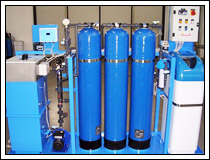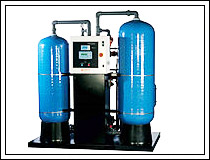De-ionization
De-ionization is a frequently used water treatment process which expeditiously removes undesirable salts and minerals from raw water to make it fit for drinking and industrial purposes. This desalination technique involves passing of water through two ion exchange materials in order to eliminate all sodium, calcium, iron,  copper and dissolved anions such as chloride and bromide. Unlike home equipment, de-ionization plants efficiently eliminate all positive metallic ions in the process and supersede them with hydrogen ions instead. When compared to chemical processes or demineralization processes like multiple distillation, de-ionization is extremely simple, user friendly and requires no costly equipment. copper and dissolved anions such as chloride and bromide. Unlike home equipment, de-ionization plants efficiently eliminate all positive metallic ions in the process and supersede them with hydrogen ions instead. When compared to chemical processes or demineralization processes like multiple distillation, de-ionization is extremely simple, user friendly and requires no costly equipment.
The Process
Ideally, deionization is executed on water already processed by methods like sedimentation or filtration that remove the bulk solids. The first stage of the process starts with passing of feed water through a bed of ion exchange resins so that the ions are replaced by H+ and OH- negative ions. Normally, there are two types of resins used in this two staged process. The first bed consists of cation resins with hydrogen ions. So, as the water is forced through this, the positive ions are replaced by hydrogen ions (H+) in the resins, which also lowers the pH of the feed water. But this pH change is canceled in the next stage so that the water coming out of this stage contains only H+ and OH- ions and nothing else.
Sometimes, a Reverse Osmosis System (RO) is placed downstream of the carbon bed to reduce high salt contents and dissolved organics. The heart of the system is an ion exchange unit, the purpose of which is to remove dissolved inorganic salts.
Because the majority of water impurities are dissolved salts, deionization produces high purity water that is generally similar to distilled water, and this process is quick and causes no scale buildup.

De-ionizing Plants
De-ionizers or de-ionization plants are commercially available as multiple bed and single bed units. Multiple bed units are fabricated with pairs of tanks - one for the cation exchanger, the other for the anion exchanger, while in a single bed unit both the cation and anion exchanger are incorporated in a single tank. A single bed de-ionizer unit produces higher quality water than the multiple bed or twin bed de-ionizing machine. This is because both the cation and anion exchangers are incorporated in a single tank, which makes it makes them equivalent to a lengthy series of twin bed de-ionizers.
|